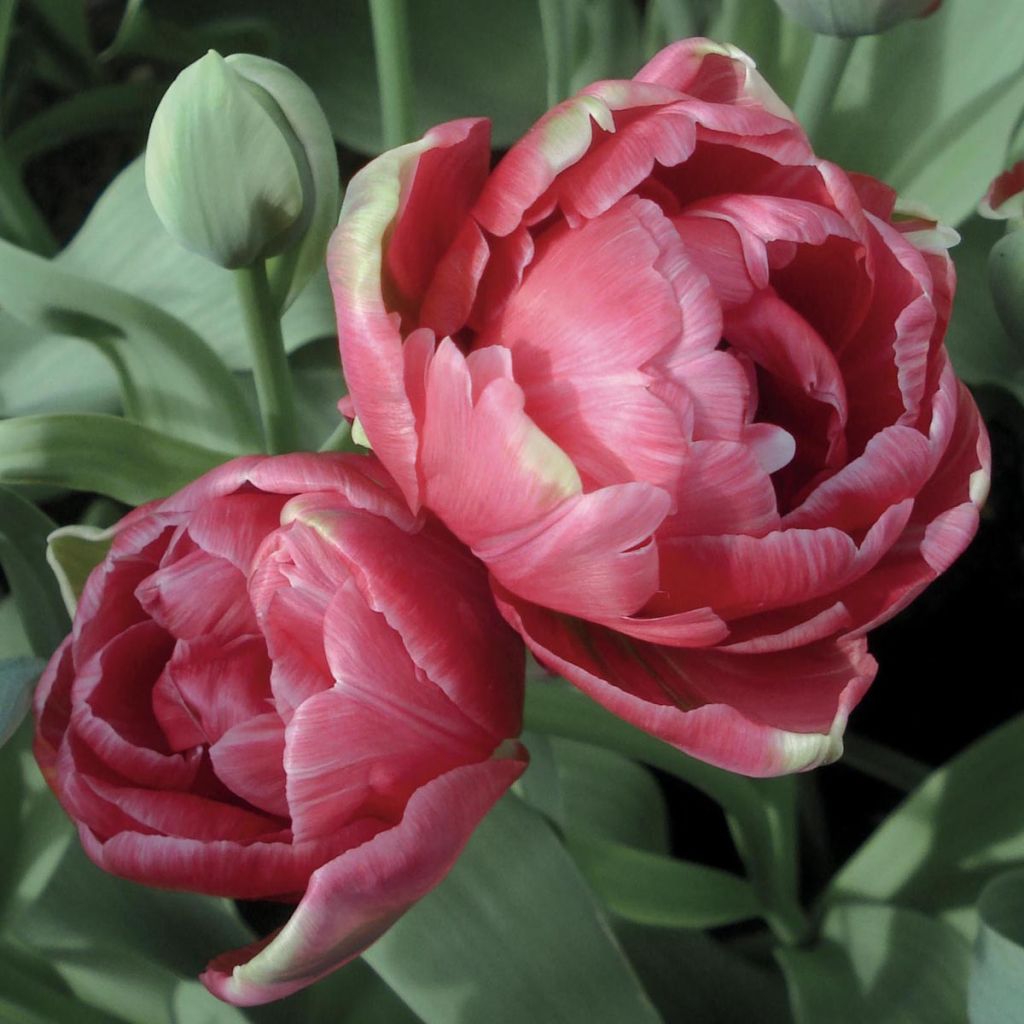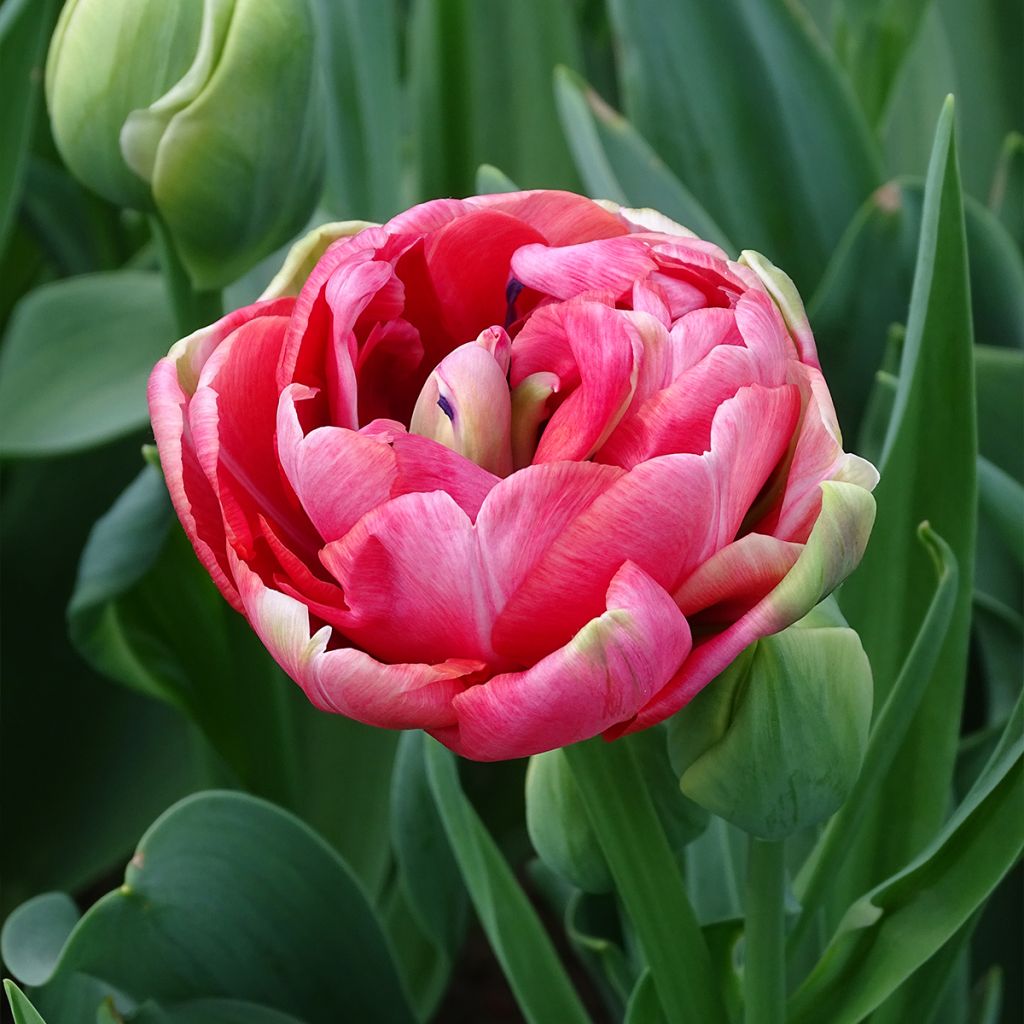

Tulipe double Wedding Gift


Tulipe double tardive Wedding Gift
Tulipa 'Wedding Gift'
Tulipa Wedding Gift
Tulip
I have planted ten young plants in a large pot, they are magnificent! Thank you.
Colette, 01/05/2016
This plant carries a 6 months recovery warranty
More information
We guarantee the quality of our plants for a full growing cycle, and will replace at our expense any plant that fails to recover under normal climatic and planting conditions.
From €5.90 for pickup delivery and €6.90 for home delivery
Express home delivery from €8.90.

Does this plant fit my garden?
Set up your Plantfit profile →
Description
The Double 'Wedding Gift' Tulip is indeed a tulip but it is a fabulous peony-like trompe l'oeil. The bright pink ball-shaped flower, finely striated with dark pink and paler edges, is a charming impostor, somewhere between an old rose and an herbaceous peony. Its flowers open in April. This rather late character is perfect for prolonging the interest of your spring beds.
The 'Wedding Gift' Tulip belongs to the Liliaceae family. Of horticultural origin, recently introduced to the horticultural market, it is currently classified in the group of 'Late Double Tulips', whose main characteristic is the presentation of fully double and crinkled flowers, in the shape of peonies, carried by weather-resistant stems. 'Wedding Gift' is of medium size (50cm (20in)) and its flower is imposing, with a diameter of 8cm (3in), double, round and well arranged, evoking a peony in full bloom. Each flower unfolds in a mix of true pink and deep pink brushed with red, then fades to a fresh pink, then reddens again, revealing a small white centre in full bloom. The flowering takes place at the end of the tulip season. To perfect the somewhat exuberant elegance of this variety, a compound foliage of large lanceolate leaves in a pretty bluish green softened with grey extends in the sun.
Incredible in the garden and fantastic as cut flowers in a vase! Combine 'Wedding Gift' tulips with other tulips like 'Maureen' or 'Angelique', bulbs like wood hyacinths (Hyacinthoides non-scripta), Muscari, or insert them into tall perennial beds like foxgloves or white Gauras, to ensure the transition between spring and summer blooms. They will also look great in pots or containers to enhance balconies and terraces.
Report an error about the product description
Plant habit
Flowering
Foliage
Botanical data
Tulipa
Wedding Gift
Liliaceae
Tulip
Cultivar or hybrid
Planting and care
Plant your double 'Wedding Gift' tulips as soon as possible in a well-drained soil. Loosen the soil deeply. Plant at a depth of 15cm (6in) (Bulbs should be covered with twice their height of soil). Space the bulbs a few cm apart, making sure they do not touch. Choose a sunny exposure for better flowering. After flowering, cut the flower stalks and let the leaves dry completely before cutting them. After flowering, their foliage becomes unsightly and we recommend planting Heuchera, Tiarella, Brunnera, Bleeding Heart, Euphorbia cyparissias in the foreground of your flower beds, their foliage will enhance the colours of your tulips and during the season, they will elegantly hide their yellowed leaves.
Planting period
Intended location
Care
-
, onOrder confirmed
Reply from on Promesse de fleurs
Haven't found what you were looking for?
Hardiness is the lowest winter temperature a plant can endure without suffering serious damage or even dying. However, hardiness is affected by location (a sheltered area, such as a patio), protection (winter cover) and soil type (hardiness is improved by well-drained soil).

Photo Sharing Terms & Conditions
In order to encourage gardeners to interact and share their experiences, Promesse de fleurs offers various media enabling content to be uploaded onto its Site - in particular via the ‘Photo sharing’ module.
The User agrees to refrain from:
- Posting any content that is illegal, prejudicial, insulting, racist, inciteful to hatred, revisionist, contrary to public decency, that infringes on privacy or on the privacy rights of third parties, in particular the publicity rights of persons and goods, intellectual property rights, or the right to privacy.
- Submitting content on behalf of a third party;
- Impersonate the identity of a third party and/or publish any personal information about a third party;
In general, the User undertakes to refrain from any unethical behaviour.
All Content (in particular text, comments, files, images, photos, videos, creative works, etc.), which may be subject to property or intellectual property rights, image or other private rights, shall remain the property of the User, subject to the limited rights granted by the terms of the licence granted by Promesse de fleurs as stated below. Users are at liberty to publish or not to publish such Content on the Site, notably via the ‘Photo Sharing’ facility, and accept that this Content shall be made public and freely accessible, notably on the Internet.
Users further acknowledge, undertake to have ,and guarantee that they hold all necessary rights and permissions to publish such material on the Site, in particular with regard to the legislation in force pertaining to any privacy, property, intellectual property, image, or contractual rights, or rights of any other nature. By publishing such Content on the Site, Users acknowledge accepting full liability as publishers of the Content within the meaning of the law, and grant Promesse de fleurs, free of charge, an inclusive, worldwide licence for the said Content for the entire duration of its publication, including all reproduction, representation, up/downloading, displaying, performing, transmission, and storage rights.
Users also grant permission for their name to be linked to the Content and accept that this link may not always be made available.
By engaging in posting material, Users consent to their Content becoming automatically accessible on the Internet, in particular on other sites and/or blogs and/or web pages of the Promesse de fleurs site, including in particular social pages and the Promesse de fleurs catalogue.
Users may secure the removal of entrusted content free of charge by issuing a simple request via our contact form.
The flowering period indicated on our website applies to countries and regions located in USDA zone 8 (France, the United Kingdom, Ireland, the Netherlands, etc.)
It will vary according to where you live:
- In zones 9 to 10 (Italy, Spain, Greece, etc.), flowering will occur about 2 to 4 weeks earlier.
- In zones 6 to 7 (Germany, Poland, Slovenia, and lower mountainous regions), flowering will be delayed by 2 to 3 weeks.
- In zone 5 (Central Europe, Scandinavia), blooming will be delayed by 3 to 5 weeks.
In temperate climates, pruning of spring-flowering shrubs (forsythia, spireas, etc.) should be done just after flowering.
Pruning of summer-flowering shrubs (Indian Lilac, Perovskia, etc.) can be done in winter or spring.
In cold regions as well as with frost-sensitive plants, avoid pruning too early when severe frosts may still occur.
The planting period indicated on our website applies to countries and regions located in USDA zone 8 (France, United Kingdom, Ireland, Netherlands).
It will vary according to where you live:
- In Mediterranean zones (Marseille, Madrid, Milan, etc.), autumn and winter are the best planting periods.
- In continental zones (Strasbourg, Munich, Vienna, etc.), delay planting by 2 to 3 weeks in spring and bring it forward by 2 to 4 weeks in autumn.
- In mountainous regions (the Alps, Pyrenees, Carpathians, etc.), it is best to plant in late spring (May-June) or late summer (August-September).
The harvesting period indicated on our website applies to countries and regions in USDA zone 8 (France, England, Ireland, the Netherlands).
In colder areas (Scandinavia, Poland, Austria...) fruit and vegetable harvests are likely to be delayed by 3-4 weeks.
In warmer areas (Italy, Spain, Greece, etc.), harvesting will probably take place earlier, depending on weather conditions.
The sowing periods indicated on our website apply to countries and regions within USDA Zone 8 (France, UK, Ireland, Netherlands).
In colder areas (Scandinavia, Poland, Austria...), delay any outdoor sowing by 3-4 weeks, or sow under glass.
In warmer climes (Italy, Spain, Greece, etc.), bring outdoor sowing forward by a few weeks.


































